The following material was adapted from “Notes from the President,” July 2016 edition. The notes were handed out at the July SCHS general membership meeting. They were written by SCHS President Stephen Hanpeter to report to the membership on the June 2016 dig at Sappington House. The Notes also reported on the finds of the dig.
The finds were significant for the history of the Sappington House and the Sappington-Concord area. They will be reported later in more detail by the archaeologists supervising the dig. There will be a preliminary report in the fall and a more comprehensive report at the conclusion of the dig, probably in three years, if the dig continues in 2017 and 2018.
The high school students, from Lindbergh and Ladue high schools, participating in the dig worked hard over the two week period. They were able to get good hands-on experience with many of the tasks that an archaeologist typically performs.
The general public was invited to visit the dig site to see the excavations in person and to watch the students at work. The visitors, both kids and adults, could get explanations of the work on the spot. The kids were invited to participate in a simulated dig. It was set up for them in a wading pool with many fun artifacts for them to find. They could record their finds in a field book that they could take home with them. There was a Mystery Mural that each person could reveal a piece of.
Visitors were also invited to attend a presentation each afternoon of the dig. The daily talks were given by area archaeologists and historians on the history of the area.
Overall, the dig at Sappington House was a fun and educational program for the high school students. Important research was done on the history of the Sappington-Concord area and the items found will be preserved in the Sappington House museum. Visitors to the site were able to learn by observation and hands-on activities about the process of archaeology. They could hear in-depth talks about archaeology and history of our area. It is an area rich in both the history of European settlement and centuries of Native American pre-history.
SCHS Programs for Kids and History
SCHS has had a number of programs in the past to promote an interest in history for kids. The SCHS was founder on initiative of the Lindbergh School district in 1992 and has continues in close relationship with the Lindbergh Schools foe 25 years. One program for kids and adults was Tombstone Tales, stories told about local residents of our area in re-enactment style. SCHS members dressed in period costume and told told their own stories as if they were still alive. Another program brought hands-on activities such as candle and soap making to kids in Lindbergh Schools classrooms. Both programs were geared towards upper elementary school-aged kids. Changes over the years in education and schools made it difficult to continues these programs.
For now, SCHS programs to inspire kids to connect with history will be provided outside of school. In the summers of 2014 and 2015 we had two programs for kids, elementary to middle school aged kids, to come to with their parents and grandparents. Mark Breckenridge, a local historical re-enactor, did presentations for kids at our July general meeting both years. The first year was on Lewis and Clark, the second year was on colonial America. Both kids and adults enjoyed Mark’s presentations. This year, our summer general meeting in July was back to an adults program to take advantage of the popular exhibit on Route 66 held at Missouri History Museum. We had Joe Sonderman speak on Route 66 and then went to see the Route 66 exhibit at Missouri History Museum.
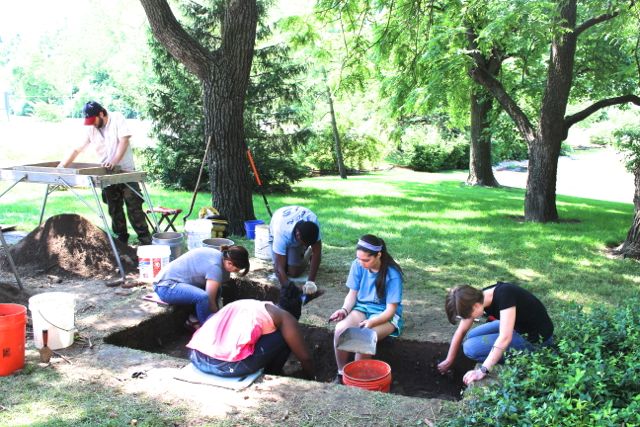
High school students working on excavation unit one, the dig at Sappington House.
The Dig at Sappington House for High School Students
Even though we could not have Mark Breckenridge do one of his programs for kids this summer of 2016, we did a much more extensive program for older kids, high school students, in June; the archaeological dig at Sappington House. The dig was a big project that we did in cooperation with the Archaeological Institute of America St Louis Society (AIA) and the Sappington House which is owned by the City of Crestwood.
Students from Lindbergh High School and Ladue High School did the digging. In fact, they did most of the activities that an archaeologist does at the site of a dig, survey, plan, plot, record, clean artifacts, prepare the site and restore the site. They were guided by two professional archaeologists provided by AIA. Also working with the students were their history teachers from their schools. The students heard a talk each day on archaeology or local history. They enjoyed the experience and will report on their findings and experiences in the fall at the US Grant National Historic Site at White Haven, on Sunday, November 20, at 2:00 pm. SCHS members and the general public are all invited to attend to hear the students speak.
While the students were digging, visitors from the general public were invited to visit the site to see the work. There also were displays and hands-on activities for both kids and adults. There was a Mystery Mural that each person could reveal a piece of. Then they could attempt an interpretation of the scene in the mural, and in making their interpretation, they had to think like archaeologists. Every visitor got a sample archaeological field guide to take home that also had basic information about archaeology. All were invited to attend the daily presentations in the Library of Americana at the Sappington House. Overall, the dig at Sappington House was a fun and educational experience for both the students and the general public.
Four excavations were opened by the students, but in the end, only one of the four produced any notable finds. What they did find was significant, the foundation to a building that probably was the summer kitchen for the Sappington House. Found in the same pit were remains similar to what would be found in a kitchen, bones and teeth, along with pieces of pottery and ceramics as well as some tools.
All of the finds were cleaned, and will be cataloged and analyzed for a final report. Copies of the report will go to the Sappington House and the SCHS archives. The actual items will go into the Sappington House museum.
There was an article published in the June 10, 2016 issue of the South County Times that focused on the students, teachers and the educational aspects of the dig at Sappington House. The following quotes are from the article, some from Ashley Lock, the participating social studies teacher from Lindbergh High School, who said of the dig, “As history teachers, we ask our students to spend a lot of time with primary source documents. This is a different form of text for the students to analyze. They are taking historical thinking skills they have learned in the classroom and applying those skills for their community.”
“The Sappington House foundation {of the summer kitchen building} was dug by hand,” said Lock. “Enslaved people and master craftsmen alike worked to build the home’s foundation. Some of my students have never held a shovel, but by doing this dig they are developing an appreciation for those who stood on this ground before them. By working on this project, they are making a connection to their local history. They are preserving that history.”
Lindbergh student Alexis Klosterman said; “I want to go into criminal justice and become a forensic anthropologist. I thought this dig would be a good way to learn about that field. I have always been curious about this kind of thing. I want to see it, not just read about it. As she described what she hoped to find, she said, “Anything is better than nothing. It’s good to know something was here even if it was just a tooth in the ground.”
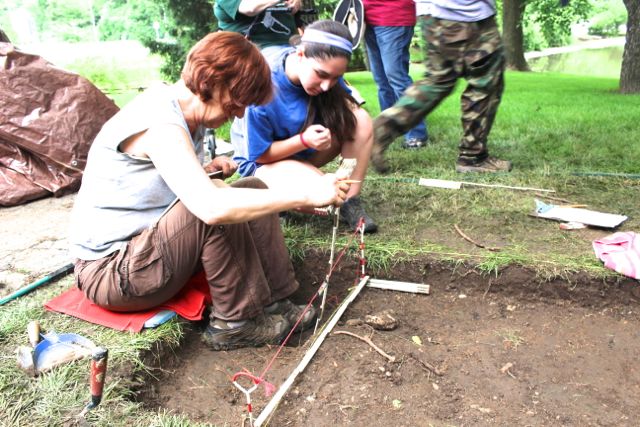
Archaeologist, Robin Machiran working with Lindbergh student, Alexis Klosterman.
Lindbergh student Evan Moss reported that, “I was interested in what we were going to try to find here and about what this means to the community.” So far, he has found pieces of bricks and an unknown piece of metal. “We are all trying to find ceramic pottery pieces but coins and other metal would be good, too.”
His teacher, Ashley Lock said further, “It’s really fun to watch the students find things. You see their faces light up as they say, ‘I found this or that.’ They are making connections here.”
“Many people are asking what we expect to find on this dig,” said Stephen Hanpeter, president of the Sappington-Concord History Society. “What is really assumed is that small, and to us everyday people, insignificant things will be found. We think they are insignificant, but in the hands of an archaeologist they are things that can tell a story of everyday life in a way that historical records cannot,” Hanpeter continued. “For example, bits of glass and pottery may tell us about the items in use by the Sappington family in the 1800s, their social and income status and where their tableware came from, the east coast or imported.”
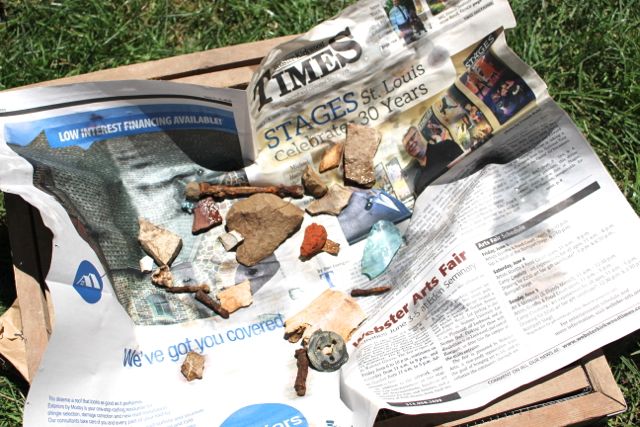
An assortment of items found in the dig at Sappington House. Items in tray drying after washing.
Preliminary report on the finds
Robin Machiran and Linda Bickle spoke in telephone interviews in August about the finds from the dig at the Sappington House. Robin is a professional archaeologist and co-owner of The Archaeological Research Center of St. Louis, Inc., the company that does contract archaeology for private clients and government connected building sites such as the Geospatial-Intelligence Agency in St Louis. Robin was the chief archaeologist supervising the dig at the Sappington House in June, working with the high school students and their teachers.
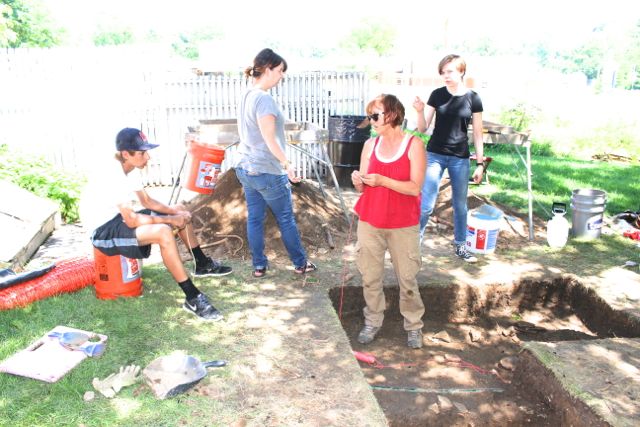
Robin, in center wearing red, working with the high school students on the dig at Sappington House, excavation unit one.
Robin’s preliminary report will be completed at the beginning of September, so for this article she could only give some first impressions. Robin thinks the building remains that they found during the dig is from the early to mid-1800s, more specifically somewhere between 1820 and the 1860‘s. As the students were digging down they first found many chunks of broken brick. Then they started finding things that would have been in a kitchen or cooking area. Near the bottom of the excavation for this year (June, 2016) they found a wall for a foundation. The wall was made of small limestone rocks, in a line stacked on top of each other. Throughout the excavation, nails and pieces of window glass were found, probably remains of the building.
Again, on first impression, it looks to Robin as if the building were either a kitchen or some kind of a place for cooking. That impression was based on finding quite a bit of kitchenware and cookware, as well as animal remains, mostly pig bones and tusks. The man-made items were mostly things to eat with, or used for food storage. The food storage items were mostly yellowware, redware and stoneware crockery.
The plates found were mostly whiteware, Ironstone with shell edge decoration. “The shell edge plates have impressed lines around the edge of the plate and early in the time period the lines were individually painted, later on they were not individually painted, but a continuous line of paint was applied to the edge of the plate. This is a less tedious and time consuming way of getting a similar effect.”
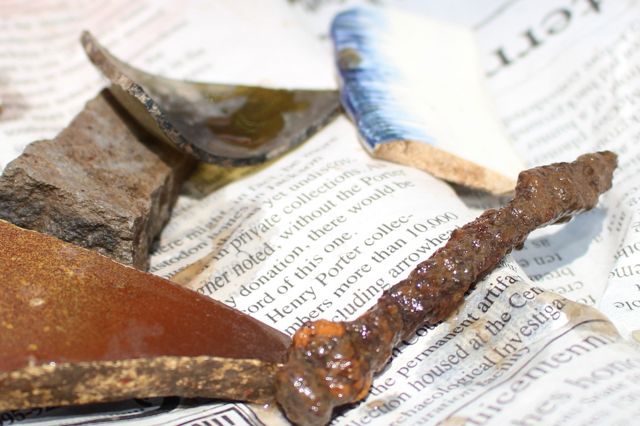
Piece of Ironstone with shell edge decoration, at upper right.
Linda Bickle, president of the Archaeological Institute of America (AIA) St. Louis Society, spoke of the finds made at the dig at Sappington house in terms of what they tell us about people’s daily lives, things that may not be found in written documents of the time. “The finds say a lot about the people who lived there, their goals, and their values.” Linda reports that two kinds of nails were found. “The hand made nails were perhaps made by the skilled worker who would have been employed on the site or maybe was a local artisan. The machine made nails might tell us about trade and the availability of manufactured products at the time in the Sappington-Concord area.”
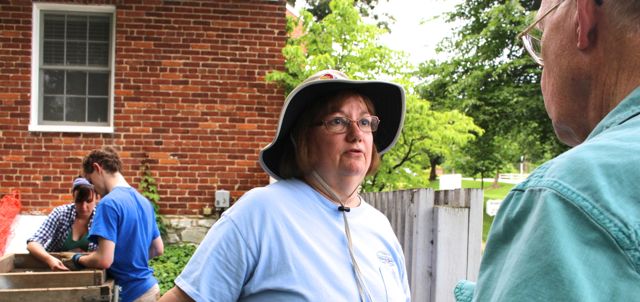
Linda Bickle talking to a visitor to the site of the dig at Sappington House.
Linda continues explaining about the possible summer kitchen building, “The limestone foundation might tell us that the builders at the site made a choice between a post and frame foundation, which would have been temporary, and the stone foundation which would have been much more durable and permanent.”
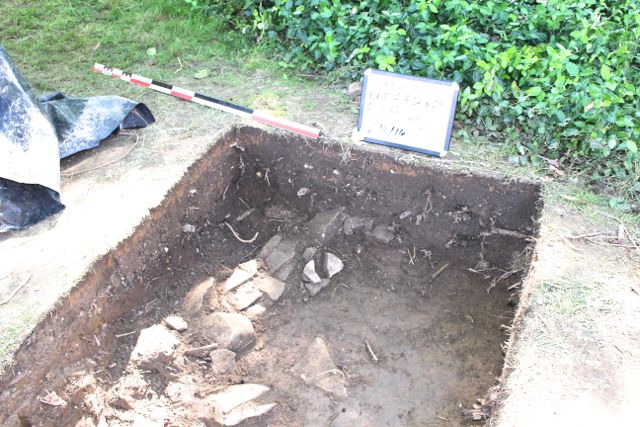
A section of the limestone foundation found in excavation unit one.
A formal report on the findings of the summer’s dig at Sappington House is being prepared by chief archaeologist, Robin Machiran. It will be turned in to the AIA St. Louis Society in early September. As the dig hopefully continues in the years 2017 and 2018, a more formal public report will be prepared. That report will be placed in the archives of the Sappington-Concord Historical Society and the museum archives at the Sappington House.
On November 20, Sunday at 2:00 pm, reports will be made on the archaeological dig at Sappington House by the students about their experiences and their findings. They will present at the Ulysses S. Grant National Historic Site auditorium at 7400 Grant Road, St. Louis, MO 63123. Seating is limited to 70 people. Reserve your seats by emailing Stephen Hanpeter at schs.webmanager@gmail.com or calling 314-918-1617.
The June 2016 dig at Sappington House was a great success. All involved in the dig were pleased with the finds. Great material of historical significance was found and preserved. The students and teachers of Lindbergh and Ladue High Schools enjoyed the dig and had a highly educational experience. The Sappington House Foundation and the City of Crestwood were pleased they could host the dig and gain further understanding of life in years past as it was lived on the site of the Sappington House. They also were pleased at the public turn out as both adults and children visited the campus to learn more about the dig, archaeology and the history of the Sappington-Concord area.
The Sappington-Concord Historical Society is pleased it could promote the study of history, historical research and preservation of history in the area. It is hoped that the dig will continue in the following two years as the students re-open the excavation at unit one to dig deeper into the past history at the Sappington House site. There is more to learn about the years the Sappington family lived on the site, and also the many hundreds of years of Native American occupation of the land.
